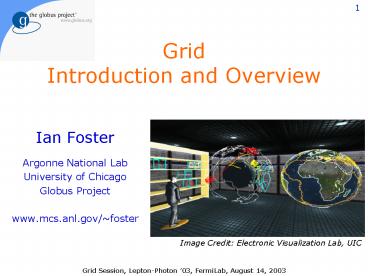Grid Introduction and Overview - PowerPoint PPT Presentation
Title:
Grid Introduction and Overview
Description:
Grid Session, Lepton-Photon '03, FermiLab, August 14, 2003 ... interfaces & behaviors for distributed system mgmt: the Grid Service ... Grid Infrastructure ... – PowerPoint PPT presentation
Number of Views:44
Avg rating:3.0/5.0
Title: Grid Introduction and Overview
1
Grid Introduction and Overview
- Ian Foster
- Argonne National Lab
- University of Chicago
- Globus Project
- www.mcs.anl.gov/foster
Image Credit Electronic Visualization Lab, UIC
Grid Session, Lepton-Photon 03, FermiLab, August
14, 2003
2
Breaking News, August 14, 2003
3
Breaking News, August 14, 2013
computational overload, not
data
data
4
Its Easy to ForgetHow Different 2003 is From
1993
- Enormous quantities of data Petabytes
- For an increasing number of communities, gating
step is not collection but analysis - Ubiquitous Internet 100 million hosts
- Collaboration resource sharing the norm
- Ultra-high-speed networks 10 Gb/s
- Global optical networks
- Huge quantities of computing 100 Top/s
- Moores law gives us all supercomputers
5
Consequence The Emergence ofGlobal Knowledge
Communities
- Teams organized around common goals
- Communities Virtual organizations
- With diverse membership capabilities
- Heterogeneity is a strength not a weakness
- And geographic and political distribution
- No location/organization possesses all required
skills and resources - Must adapt as a function of the situation
- Adjust membership, reallocate responsibilities,
renegotiate resources
6
For Example High Energy Physics
7
Resource Integrationas a Fundamental Challenge
8
Grid TechnologiesAddress Key Requirements
- Infrastructure (middleware) for establishing,
managing, and evolving multi-organizational
federations - Dynamic, autonomous, domain independent
- On-demand, ubiquitous access to computing, data,
and services - Mechanisms for creating and managing workflow
within such federations - New capabilities constructed dynamically and
transparently from distributed services - Service-oriented, virtualization
9
The Grid World Current Status
- Substantial number of Grid success stories
- Major projects in science
- Emerging infrastructure deployments
- Growing number of commercial deployments
- Open source Globus Toolkit a de facto standard
for major protocols services - Simple protocols APIs for authentication,
discovery, access, etc. infrastructure - Large user and developer base
- Multiple commercial support providers
- Global Grid Forum community standards
- Emerging Open Grid Services Architecture
10
The Emergence ofOpen Grid Standards
Increased functionality, standardization
Custom solutions
1990
1995
2000
2005
2010
11
Grid Evolution OGSA (Open Grid Services
Architecture)
- Goals
- Refactor Globus protocol suite to enable common
base and expose key capabilities - Service orientation to virtualize resources and
unify resources/services/information - Embrace key Web services standards, leverage
commercial efforts - Result standard interfaces behaviors for
distributed system mgmt the Grid Service - Standardization within Global Grid Forum
- GT3 open source implementation
- OGSA Web services on steroids!
12
Open Grid Services Infrastructure (OGSI)
Resource allocation
Create Service
Authentication Authorization are applied to all
requests
Grid Service Handle
Service factory
Service requestor (e.g. user application)
Service data Keep-alives Notifications Service
invocation
Service discovery
Register Service
Service registry
Service instances
Interactions standardized using WSDL and SOAP
13
OGSA Standardization Implementation
- OGSI defines core interfaces and behaviors for
manageable services - Efforts are underway within GGF, OASIS, and other
bodies to define standards for - Agreement negotiation
- Common management model
- Data access and integration
- Security and policy
- Etc., etc., etc.
- Supported by strong open source technology
major commercial vendors
14
Grid Infrastructure
- Broadly deployed services in support of
fundamental collaborative activities - Formation operation of virtual organizations
- Authentication, authorization, discovery,
- Services, software, and policies enabling
on-demand access to critical resources - Computers, databases, networks, storage, software
services, - Operational support for 24x7 availability
- Integration with campus and commercial
infrastructures
15
Open Infrastructure
16
Where We AreWhat We Can Do Today
- A core set of Grid capabilities are available and
distributed in good quality form, e.g. - Globus Toolkit security, discovery, access, data
movement, etc. - Condor scheduling, workflow management
- Virtual Data Toolkit, NMI, EDG, etc.
- Deployed at moderate scales
- WorldGrid, TeraGrid, NEESgrid, DOE SG, EDG,
- Usable with some hand holding, e.g.
- US-CMS event prod. O(6) sites, 2 months
- NEESgrid earthquake engineering experiment
17
(No Transcript)
18
NEESgrid Earthquake Engineering Collaboratory
U.Nevada Reno
www.neesgrid.org
19
CMS Event Simulation Production
- Production Run on the Integration Testbed
- Simulate 1.5 million full CMS events for physics
studies 500 sec per event on 850 MHz processor - 2 months continuous running across 5 testbed
sites - Managed by a single person at the US-CMS Tier 1
20
CMS Event Simulation Production
- Production Run on the Integration Testbed
- Simulate 1.5 million full CMS events for physics
studies 500 sec per event on 850 MHz processor - 2 months continuous running across 5 testbed
sites - Managed by a single person at the US-CMS Tier 1
1.5 Million Events Delivered to CMS
Physicists! (nearly 30 CPU years)
21
Where We AreKey Areas of Concern
- Integration with site operational procedures
- Many challenging issues
- Scalability in multiple dimensions
- Number of sites, resources, users, tasks
- Higher-level services in multiple areas
- Virtual data, policy, collaboration
- Integration with end-user science tools
- Science desktops
- Coordination of international contributions
- Integration with commercial technologies
22
SummaryGrid Past, Present, Future
- Past
- Origins and broad adoption in eScience, fueled by
open source Globus Toolkit - Present
- Rapidly growing commercial adoption focused on
intra-enterprise resource sharing - Increasingly large scale infrastructures
- Open Grid Services Architecture (OGSA)
- Future
- Key enabler of new applications industries
based on resource virtualization and distributed
service integration
23
For More Information
- GriPhyN, iVDGL, PPDG
- www.griphyn.org, www.ivdgl.org, www.ppdg.net
- The Globus Project
- www.globus.org
- Global Grid Forum
- www.ggf.org
- Background information
- www.mcs.anl.gov/foster
- GlobusWORLD 2004
- www.globusworld.org
- Jan 2023, San Fran
2nd Edition November 2003































